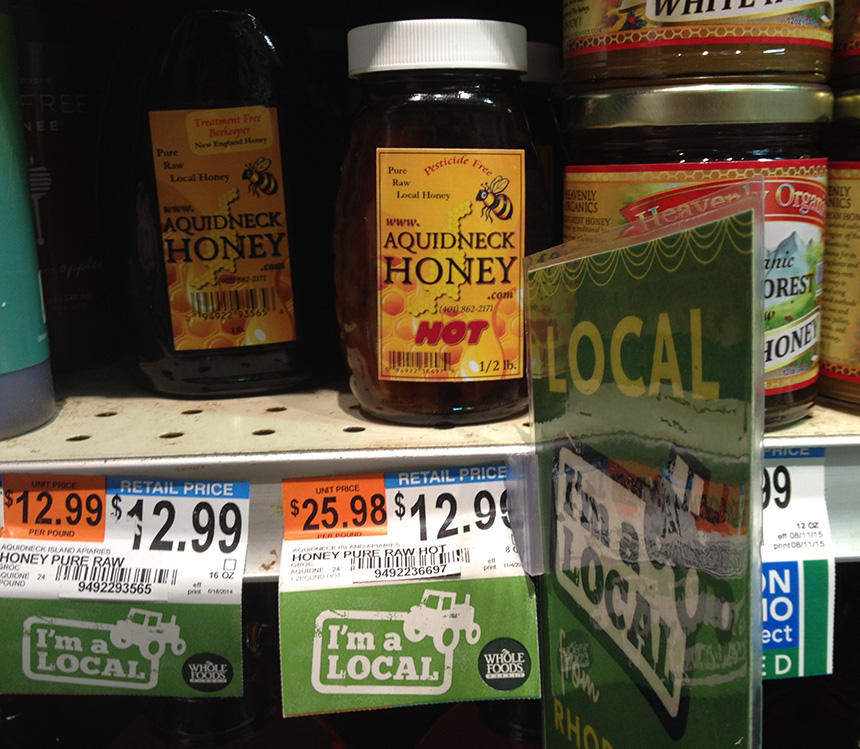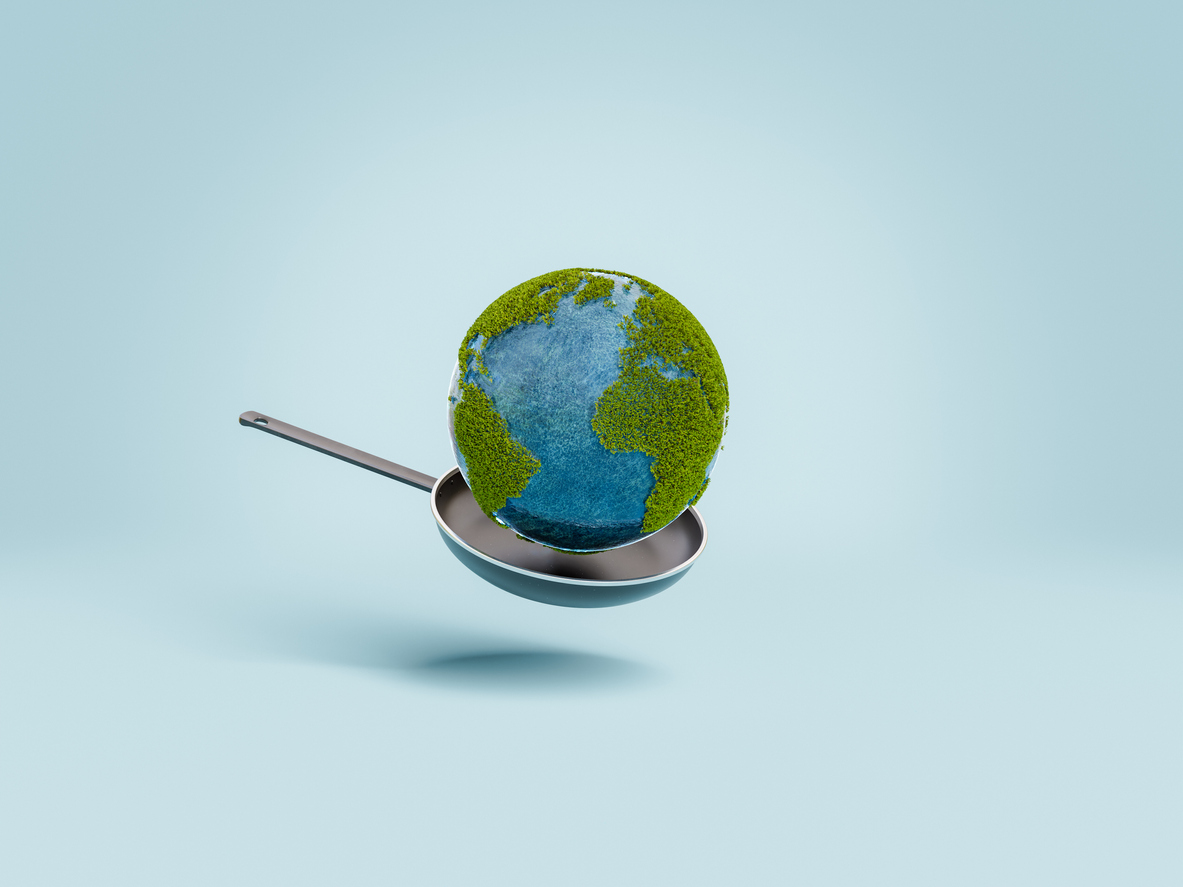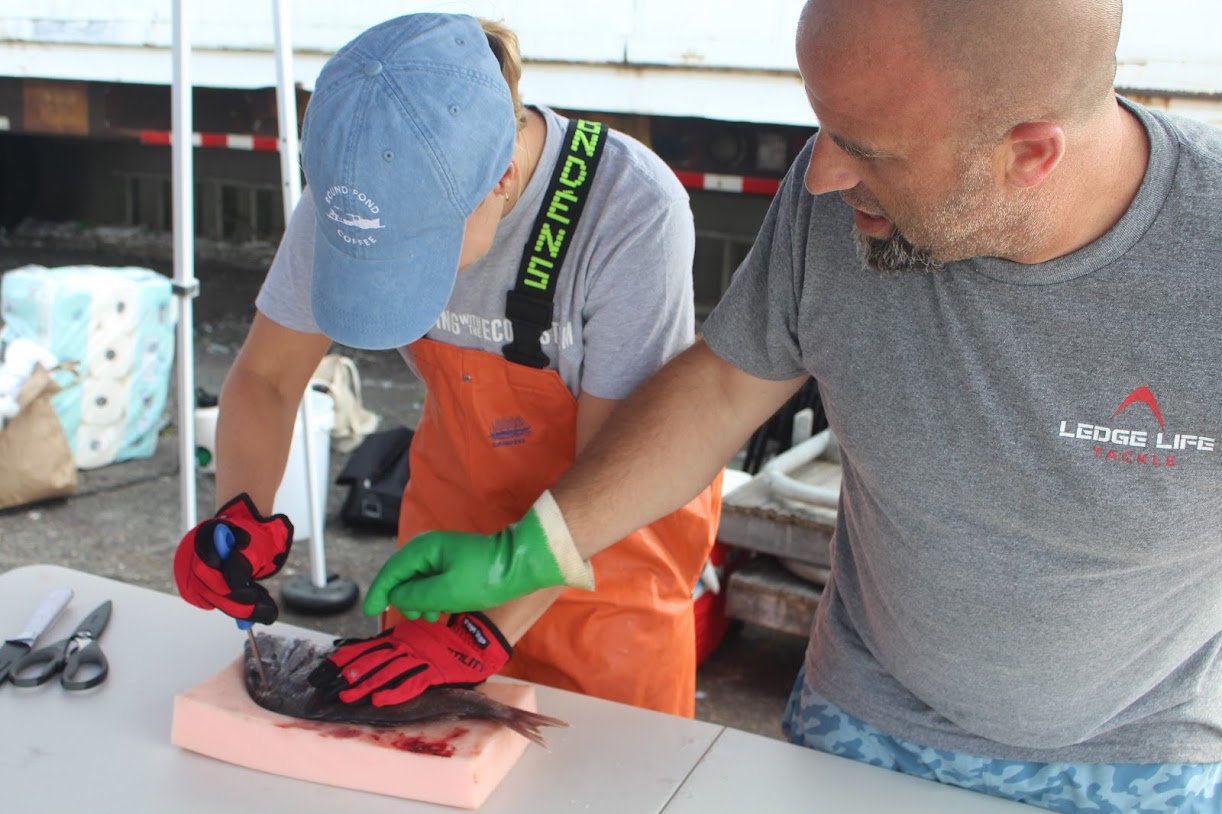Peeling Back the Label: The Bitter Truth About Food
Marketing gimmicks and the ruthless rush for profits have stolen the meaning of local and many other food labels
April 25, 2016
The local food movement, through no fault of its own, is now defined by words and phrases that aren’t as friendly as they sound, or even accurate. Advertising agencies, multinational corporations and greed have stolen the meaning of “local.”
In the name of higher CEO pay and greater profit, overworked and underpaid consumers have been left to untangle what “local” and other labels, such as “natural,” “free range,” “grass fed,” “cage free” and “artisan,” actually mean.
Subway, the fast-food chain that, until recently, used a chemical, azodicarbonamide, found in shoe rubber, synthetic leather and yoga mats in its bread manufacturing, noted in TV commercials earlier this year that its sandwiches are “handmade.” Sounds great, but what does that actually mean? Absolutely nothing.
Last year, Kraft Singles, those individually wrapped slices of heavily processed “cheese product,” became the first “food” to earn a nutrition seal from the Academy of Nutrition, the trade group that represents 75,000 registered nutrition professionals. These slices can’t be called cheese, because less than 51 percent of their composition is actually cheese. The rest is composed of other ingredients, such as milk protein concentrate, a cheap milk byproduct.
The Kraft Foods Group, a global food power, was awarded permission to use the academy’s “Kids Eat Right” healthy label to better market its fake cheese to parents. The deceptive marketing stunt quickly failed, thanks to public backlash, and the bogus label was removed from the faux cheese.
Food labels are designed with profits, not environmental protections, animal welfare, public health, authenticity or the truth, in mind. They’re abused as marketing tools to cheat consumers and genuine businesses. That wasn’t their original intent.
When the food-labeling movement began, in the 1970s in California, it was intended to let consumers know that their produce wasn’t tainted with herbicide and pesticide residue. Back then, buying food certified with the California Organic Standard meant you were an “earthy-crunchy, bean-sprout and granola-eating hippy.” It also meant you were in a small percentage of consumers worried about chemical use in food production.
By the late 1980s, however, when reports about a possible cancer-causing chemical manufactured by the Uniroyal Chemical Corp. — now the Chemtura Corp. — and used on apples went public, the number of concerned consumers grew. Alar, a growth-regulating hormone, was sprayed on apples from the early 1960s to the late ’80s, to hold them on the tree longer and reduce bruising. In 1989, it became illegal to use the chemical on U.S. food crops, but it’s still allowed for use on non-food crops.
A decade later, when multinational food manufactures such as General Mills and Coca-Cola discovered “organic,” “farm raised” and “old-fashioned” produced profits, there was an explosion of food labels claiming this or promising that.
These global behemoths, and others, started buying up organic companies to diversify their portfolios, and, since then, the labeling of food has been trivialized. Deceptive labeling practices are now being committed by all types of producers, large and small.
The food critic for the Tampa Bay Times recently conducted a two-month investigation of Tampa’s farm-to-table restaurants, tracking down their sourcing claims. Many turned out to be bogus. Blackberries from Mexico and blueberries from California aren’t Florida local. She also discovered “Florida blue crab” comes from the Indian Ocean.
It’s important to make consumers aware that the definition of local is muddy and often misused, according to Karen Schwalbe, executive director the Southeastern Massachusetts Agricultural Partnership.

Costly wording
Food labeled “local” is largely taken for granted by consumers, despite the fact that they can be buying, often at a premium, something that isn’t actually being produced locally and/or using local ingredients.
So who is keeping tabs on the local label? No one. It’s largely up to consumers to find out if labeling claims are true. It’s not an easy task.
The U.S. honey market, for example, is riddled with corruption and fraud, according to one of the country’s top pollen researchers. Vaughn Bryant, director of the Texas A&M University Palynology Laboratory and Paleoethnobotany Laboratory, told ecoRI News in early March that most of the honey sold in the United States and Canada isn’t what is printed on the label.
“Consumers are getting screwed all over the place,” he said. “What they’re paying for is not what they’re getting.”
In southern New England, Jon Nelson, of B.B. Nelson Apiaries in Woonsocket, R.I., has seen firsthand the deceptive labeling practices used by people he calls “packers.” He said these people buy what is commonly referred to as “bucket honey” — 60 pounds of honey in a 5-gallon pail — from distributors and pack it into jars affixed with labels that claim the honey is local.
He knows this practice is commonplace because he sells bucket honey to buyers in both Rhode Island and Massachusetts. He’s seen these pails with the label removed and “Rhode Island Honey” written across the lid.
Consumers are tricked into paying a premium for repackaged bulk honey labeled “local” that likely came from South America or China. The federal government estimated that last year 91 million pounds of honey, much of it from China, entered the United States illegally, according to Bryant.
The practice of creative labeling isn’t illegal in Connecticut, Massachusetts or Rhode Island. Nothing in the Food and Drug Administration’s convoluted labeling regulations addresses the shadiness of labeling distributor honey “local.”
Bryant said he has been told by FDA officials that, despite rampant labeling abuse, the federal agency doesn’t consider the problem a high priority. Federal law only prohibits adding water or high-fructose corn syrup to honey.
The Texas A&M researcher has spent the past four decades testing honey from around the globe. He entered the world of honey in 1976, when asked by the Office of Inspector General of the U.S. Department of Agriculture to examine domestic honey bought by the federal government as part of its farm subsidy program. He’s been keeping tabs on the market ever since.
Several years ago, he and a colleague tested some 70 jars of honey bought in big-chain stores in 12 different states and found only a few contained what was actually printed on the label. His research has also found that more than 75 percent of honey sold in the United States has had its pollen filtered out.
Bryant has worked with lawyers in California, Florida and New York, and with state agricultural departments in North Carolina and West Virginia, all of whom have tried to enforce honey labeling laws. In court cases against major food retailers that were accused of mislabeling honey, they lost because judges noted that the FDA has no rules about truth in labeling for honey, he said.
Naive consumers, willing to pay more for honey they believe was harvested from, say, hives on Aquidneck Island or in Cumberland, R.I., to help with springtime allergies, can end up buying marked-up honey made from bees in China, North Dakota, Argentina or Brazil.
“Consumers are buying high-priced honey labeled orange blossom and buckwheat for premium prices, and it’s absolutely junk,” Bryant said. “And they have no recourse, because there are no laws or requirements when it comes to labeling honey. It’s frustrating.”
ecoRI News asked Bryant what consumers can do to protect themselves. His answer wasn’t encouraging: “I have no idea.”
Honey, however, is hardly the only product manipulated by creative labeling.
Rhode Island’s largest egg producer boasts that it sells “eggs from local hens.” While true, that rosy picture of farm life, which also makes use of the label “natural,” fails to note that up to 10 hens live in wire containers, called battery cages, that are about the size of a small oven. There’s nothing natural about that arrangement.

Label makers
Consumers don’t know how much pesticide and herbicide is sprayed on their food, or the amount of antibiotics and hormones injected into the meat they consume. In 2014, according to the FDA, U.S. livestock operations used 20 million pounds of antibiotics, while doctors prescribed about 7 million pounds.
Many consumers don’t realize how much agribusinesses such as Monsanto control their food supply. Labeling misuse only adds to consumer confusion.
A 2015 Consumer Reports study found that nearly two-thirds of shoppers are being misled to believe the label “natural” means more than it does. As an example, the study noted that some “natural” shredded cheese contains natamycin, a pesticide. “Natural” fruit snacks can contain artificial preservatives such as sodium benzoate and potassium sorbate.
In fact, the label “natural” helps sell nearly $41 billion worth of food in the United States annually, according to Consumer & Shopper Insights. The FDA, though, doesn’t even have an official definition of what “natural” means.
Dan Bensonoff, policy director for the Natural Organic Farmers Association/Massachusetts, said the word “natural” is completely meaningless when it comes to food. “There’s no rules around natural,” he said. “It’s a challenge for consumers to know what all these labels mean.”
This growing, and largely unregulated, use of marketing labels is propped up by politics and profit. Bensonoff noted that corporate pressure from Big Ag has left labeling regulations loose.
For example, the label “free range” doesn’t mean chickens, pigs and cattle enjoy their limited existence roaming lush-green pastures and sunlit farmland. In fact, U.S. Department of Agriculture (USDA) regulations for free-range certification apply only to poultry.
The USDA requires that “free-range” chickens and turkeys raised for their meat have “access” to the outside. There is no requirement for access to pasture; their outside access can be limited to dirt and gravel. There also are no requirements for the size of an “outside range.”
There is no legal definition for “free-range” chicken eggs, and the term doesn’t explain what an animal eats. It’s likely manufactured feed, not bugs and grubs.
Many chickens labeled “free range” are raised quickly for profit, in about seven weeks. For the first five weeks they’re not allowed outside, as exercise would decrease the size of their breasts, which provide the more popular white meat.
The terms “free range,” “pasture raised,” “grass fed” and “cage free” are less husbandry terms and more advertising gimmicks.
“Grass fed” certification by the USDA doesn’t deal with the use of hormones and antibiotics, confinement of animals or environmental stewardship. “Cage free” simply means chickens can’t be raised in concentrated animal feeding operations, such as battery cages.
A mass-produced mayonnaise is currently being hyped as being made from “real ingredients,” such as cage-free eggs. Hellmann’s is manufactured by Unilever, a multinational consumer-goods company, and the product’s ingredients include calcium disodium EDTA, which is also used in the textile and paper industries, and natural flavors, the fourth-most common ingredient listed on food labels.
In fact, the difference between natural flavors and artificial flavors is slight. One (artificial) is synthetically processed in a laboratory and one (natural) is purified in a laboratory.
In the expanding model of using labels to make money, the use of the term “organic” is no less confusing. The designation also can be expensive, for both producers and consumers. In fact, some organic farmers can’t even afford to have their produce labeled “organic.” Major food manufacturers such as Dean Foods, Kelloggs and Nestlé have little problem filing the reams of paperwork needed to obtain federal organic certification.
Bensonoff said the red tape is a big reason why organic farmers like him don’t seek the certification. “It’s a combination of factors, but the paperwork is a concern,” he said. “Farmers also don’t want to be tied down with a label, or don’t want a federal label they don’t believe is necessary.”
USDA “organic” products can be labeled differently depending on the percentage of organic ingredients they contain. Products made entirely with certified organic ingredients and methods can be labeled “100 percent organic.” Products with at least 95 percent organic ingredients can use the word “organic” — even if the other 5 percent was bathed in a concoction of pesticides, herbicides, hormones and antibiotics. Both designations can display the USDA organic seal.
A third category, containing a minimum of 70 percent organic ingredients, can be labeled “made with organic ingredients.”
Much like the country’s cumbersome and loophole-ridden tax system, the food-labeling system has been crafted with the help of special interests and Big Business. The more confusing the better.
The solution? Have conversations with local food producers.
“Buy as close to home as possible,” Bensonoff said. “Get to know your farmer. Visit and take a look around.”




It is fine to call out the agribusiness producers for conning us with terms like "natural", any half-awake consumer doesn’t really expect the likes of Kraft or Pepsico or General Mills to be honest about their products. Remember the "corn sugar" campaign for GMO high fructose corn syrup? Or the recent mayonnaise commercial for a product made by "farmers committed to responsibly-sourced oils" (GMO canola oil anyone?)? It’s the cigarette fiasco all over again. They lie. And we know it.
But let’s not give the local guys a free pass. They are just as guilty of spin as the big guys and, unfortunately, we fall for it because we want to believe. Let’s start with the Aquidneck Honey shown in your article: it is labeled "pesticide-free." Even if they did collect honey locally, do they claim to know, with certainly, that every single flower visited by every single bee is free of pesticides? Of course not. It is illegal labeling (or should be). And what about FramFreshRI? If you go to their website and search on "organic" only five of their farms are certified organic, the remainder use "integrated pest management" (which means they use pesticides but feel guilty about it), are "chemical-free" (which has absolutely no meaning, oversight or enforcement and, what, they don’t fertilize? Nitrogen is a chemical…), or are GAP-certified (which means they try their best not to microbially-contaminate their products. Gee, thanks.). And RhodyFresh? Well, they claim not to use artificial growth hormone (good), but what do they feed their cows? Bt corn? Glyphosate-tolerant alfalfa? Cute little local labels mean nothing. I challenge people to go to local farmers markets and specifically ask if their produce is organic; it is eye-opening. After doing so several times, I often leave the market empty-handed. And those iconic Rhode Island road-side sweet corn stands? I don’t even want to think about it.
Now, I realize that the USDA Organic Program has been and continues to be co-oped by "enemy" interests, but it is all we have at the moment and needs to be protected. And I’m not disparaging local efforts to support locally-grown, organic produce, even those I mentioned above. Believe me, I will be first in line and willing to pay the premium if their product is truly organic. Furthermore, I do know there are local farmers who put the effort in to be certified organic and I thank them. But there are businesses in RI that are spinning the hype just as hard as the big guys to get our money, and I feel we have been suckered into believing that local is better from a food quality perspective. I’m not convinced at all. So, look at the labels, but also at signs and claims and advertisements, and don’t let the "local" green-washing get you.
It’s concerning to me that you would quote from the Genetic Literacy Project: "A GMO lobbying outfit funded by Monsanto, run by the infamous Jon Entine, the world’s leading biotech shill and character assassination operative." http://www.truthwiki.org/genetic-literacy-project/